A perfectly smoked brisket is the king of BBQ. I myself have been intimidated by this cook and have tried many methods. After having some of the best brisket from places like Truth BBQ in Houston Texas, it’s hard to even compare. But after some trial and error, I have found a simple method that works every time. Enjoy some tender, flavorful, and juicy smoked brisket using my process.
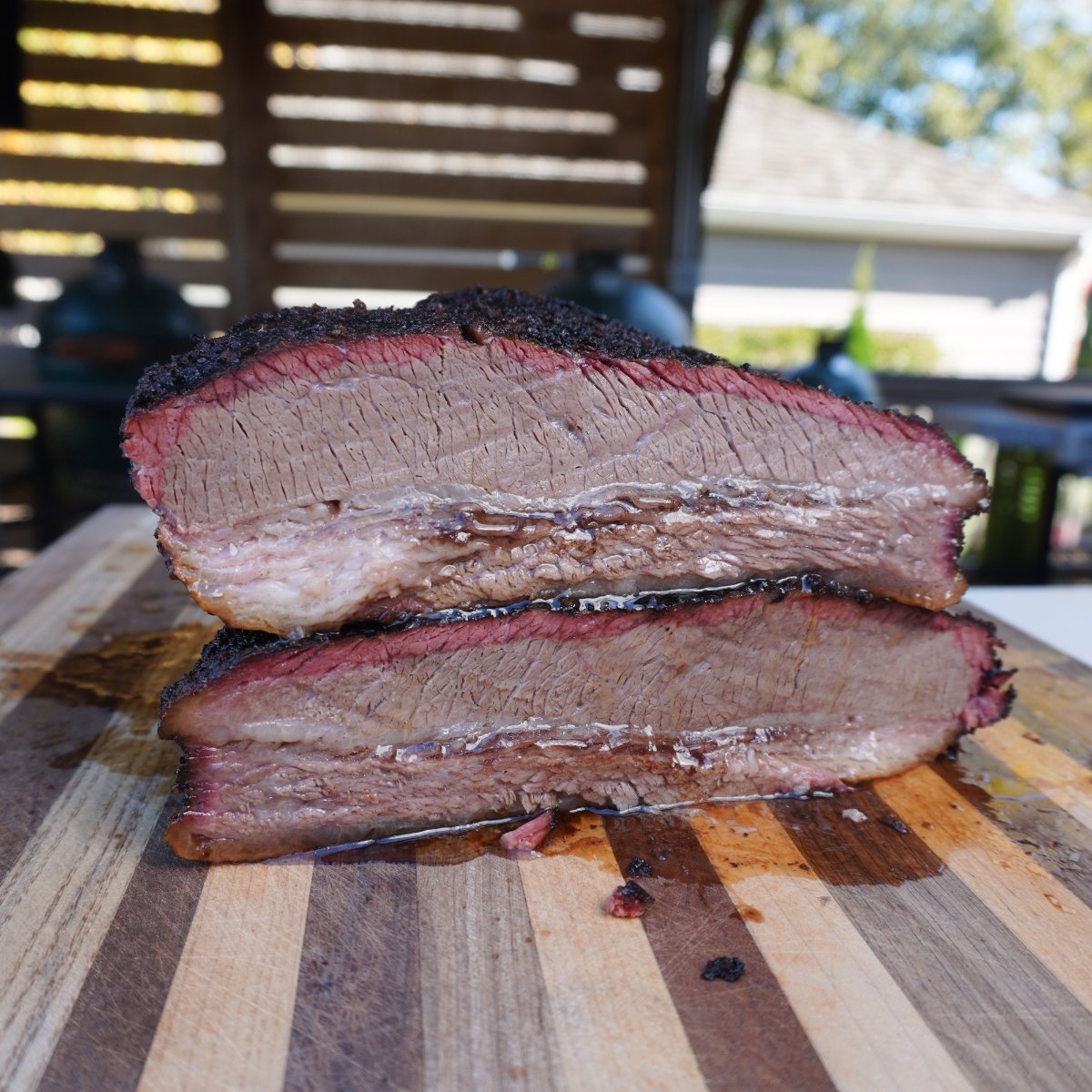
Why is a smoked brisket so popular.
Beef brisket is superior to other cuts of meat in the BBQ world because of the flavor and care it needs to get the perfectly smoked meat. Packed with fat and strong beef flavor, when done right, smoked brisket is the most tender cut of meat. Because of all the connective tissue, this cut needs a lot of time to cook, therefore the low and slow method works best.
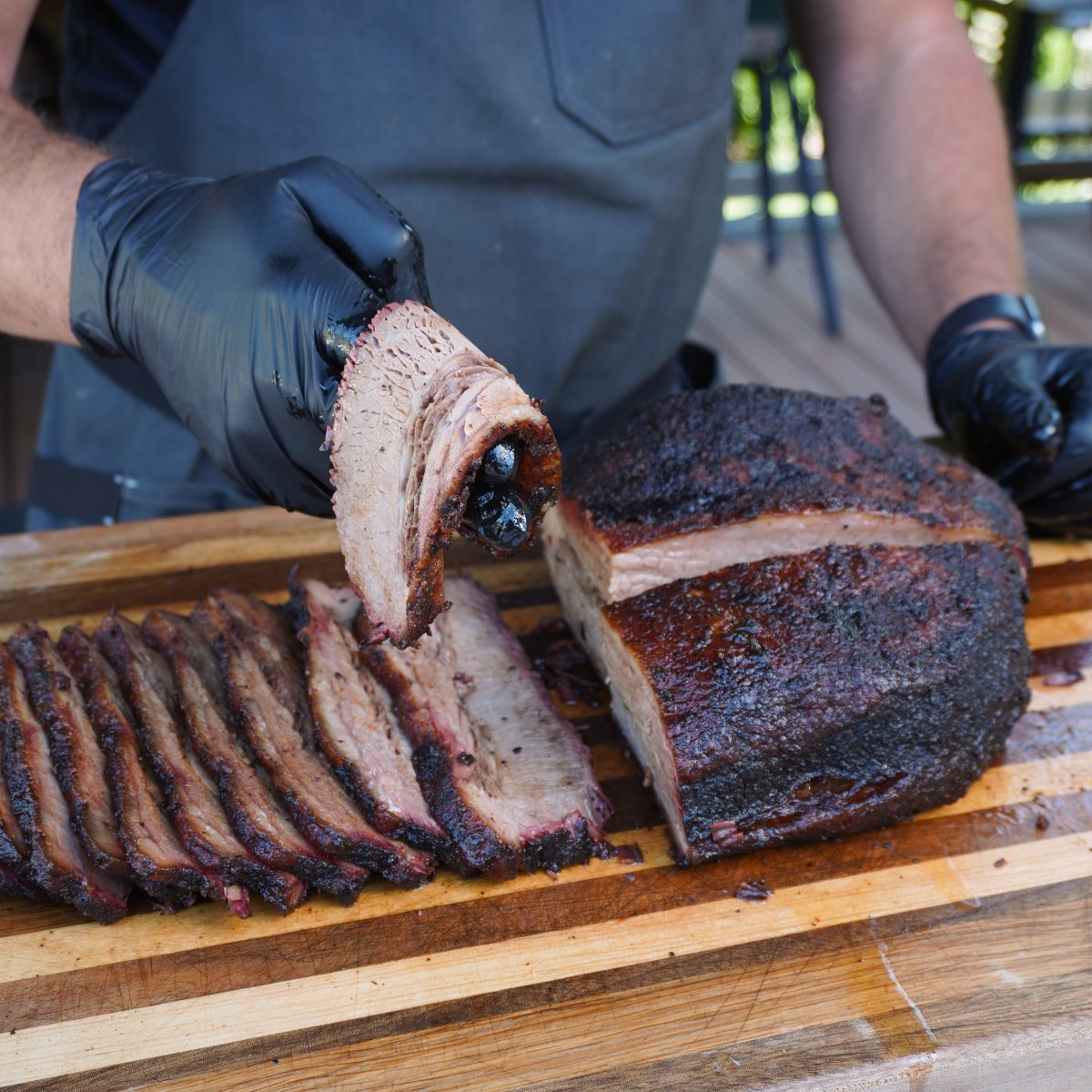
Where does the brisket come from?
Each cow has 2 briskets, making it a valuable cut. Also, quality and grade will play a large role in the price of a brisket. USDA Prime is higher quality grade meat with more marbling, while Choice has less which helps if you are looking for a cheaper option.
In addition to the grade, the cut and trim level of the beef brisket will have an impact on the price. A whole untrimmed brisket may be cheaper than a cleanly trimmed , pre-packaged option. I highly recommend an untrimmed brisket.
Tips to smoking a brisket
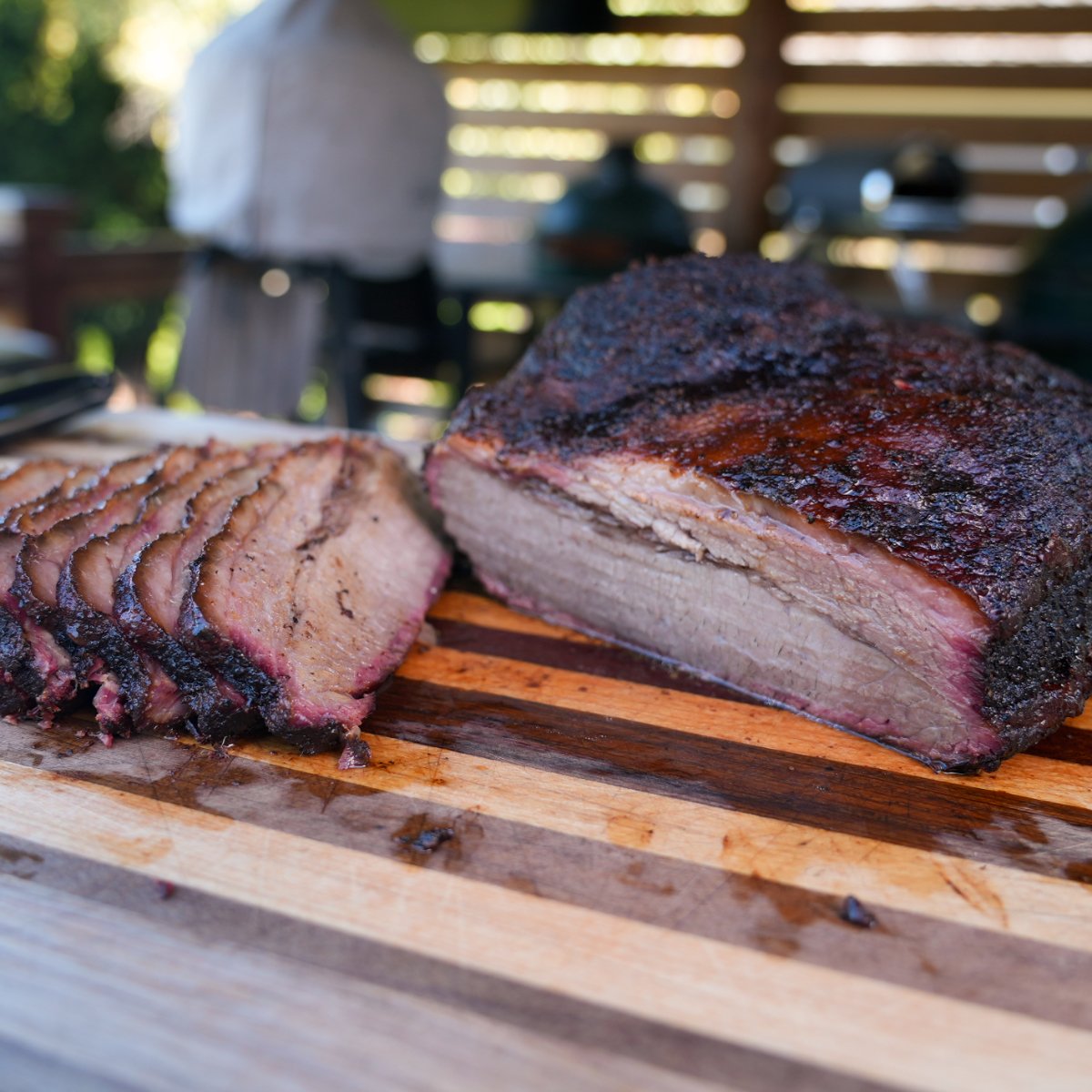
There are multiple ways to smoke a brisket. If you ask 20 pit smokers on the perfect method, each will have a different answer. People spend their careers perfecting a smoked brisket. Each method will result in a deliciously flavorful tender and juicy brisket.
Size
The ideal weight for a brisket should be between 10-13 lbs. A brisket below 10 lbs. is most likely to dry out during the cooking process, while a brisket heavier than 13 lbs. will take too long to cook and might cook uneven.
Trim
Properly trimming a brisket will set you up for success. Aerodynamics is key in achieving an evenly smoked brisket. Removing the hard fat is necessary, it will not render down. Shape the brisket evenly by trimming all sides and leaving a fat cap side.
Temperature
Consistent low and slow temperature is vital to smoking a brisket. This is key to obtaining that tender and juicy meat, have the fat and connective tissue render down for that perfect cut of meat.
You can smoke a brisket on any grill. As long as you can maintain a low and steady temperature, the cook is possible.
- Smoker: the most traditional grill used to smoke a brisket. Requires constant supply of wood to keep the fire and heat leveled. Adding chunks of apple wood, hickory or oak can add additional smokey flavor.
- Pellet Smoker: this grill makes smoking a brisket easy. It removes all the nuances of a smoker. It’s as simple as set it and forget it. A pellet smoker can keep consistent temperatures for hours, allowing you to smoke one overnight and still getting a good nights rest.
- Charcoal grills: These grills also require an indirect set up for smoking a brisket. There are a lot of accessories you can purchase to achieve this. From charcoal baskets to low and slow kits. The key is to make sure you have enough hot coals to keep the temperature consistent and steady.
Step 1: How to trim the brisket
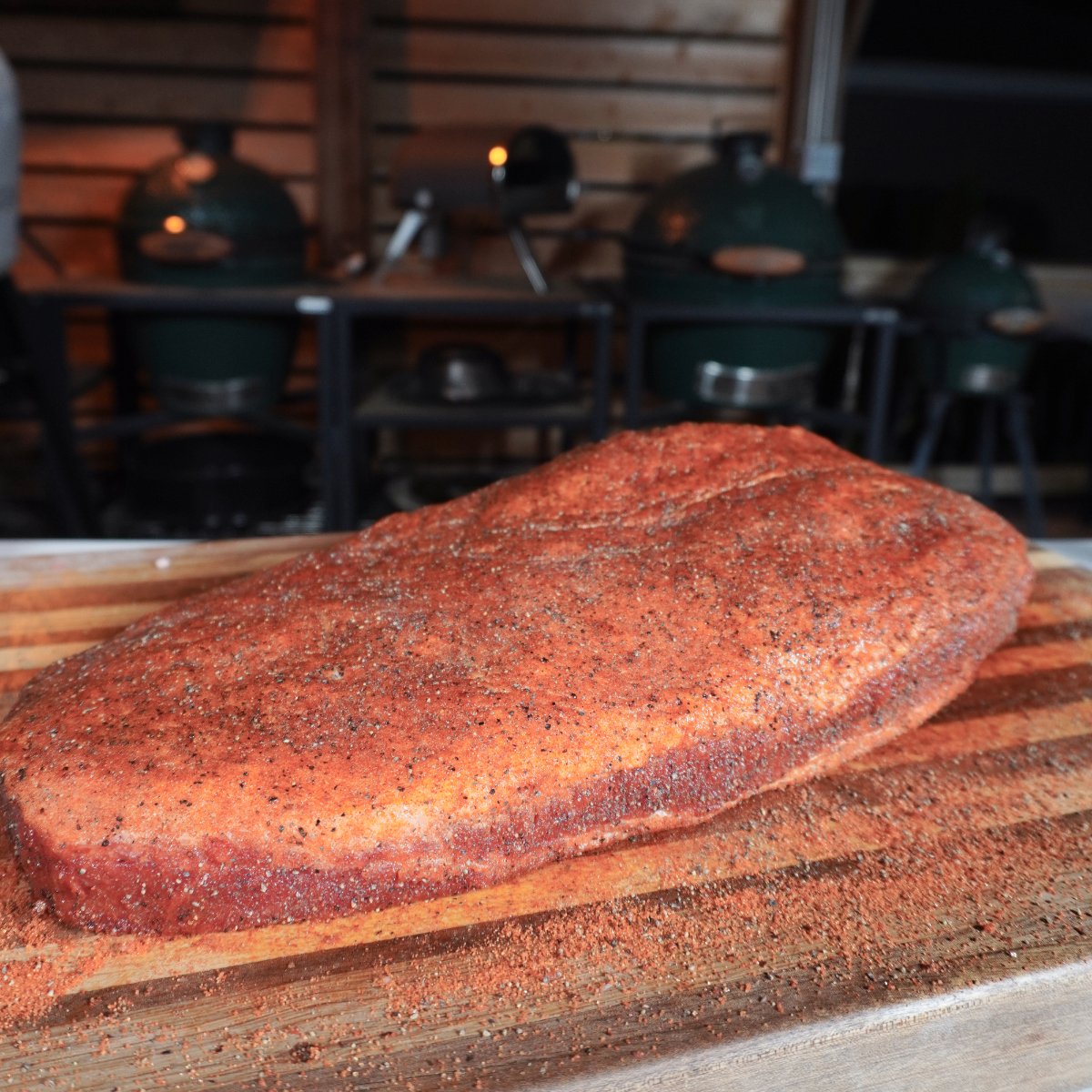
Trimming a brisket is a very crucial step to achieving a perfectly smoked brisket. This is a step that requires time and patience.
Start by placing the brisket in the freezer for 1 hour. This will harden the fat making it easier to trim.
Inspect the brisket and remove any loose fatty ends. Using a trimming knife, slowly start sculpting the brisket, shave small pieces to avoid removing too much off. You want your brisket to have fat when it hits the grill.
The point or higher section on the brisket usually has a hard fat cap. This will not render down and make for one unpleasant bite. Slowly shape this area by removing thin and even slices off making the entire piece more aerodynamic.
By the time you are done, there should be an even 1/4 inch of fat cap left on the top.
Recipe Tip
Do not rush the brisket trimming process. Slice off small and thin slices of fat at a time.
Step 2: Season the brisket
There are multiple ways of seasoning a brisket. This is a very large piece of meat and can handle a lot of seasoning.
Start by spreading yellow mustard all over the trimmed brisket. This will work as the binder for the seasoning. Because of the large cut of meat, you will not be able to taste the mustard once cooked. For the seasoning, what I found works best for me is using a combination of my Dad’s All Purpose seasoning which has notes of salt, pepper and paprika, along with a layer or coarse ground black pepper. This will give the brisket a nice dark bark.
Step 3: How to smoke a brisket
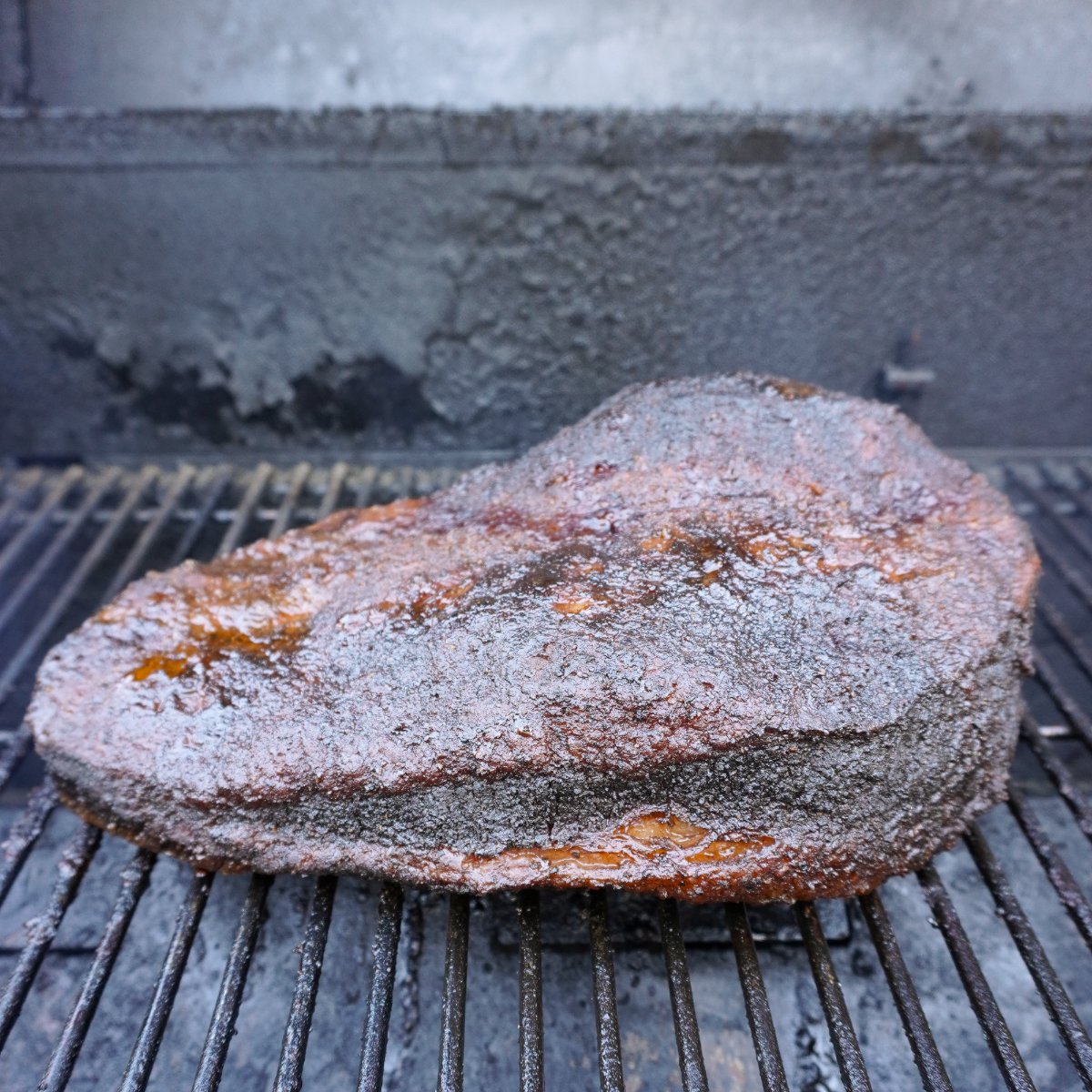
Low and slow is key in getting a tender smoked brisket. I used my pellet smoker which removes all the worry for me. Set it and forget it.
Preheat the smoker to a low 225 degrees. Make sure the hopper is full of pallets.
Place the well seasoned brisket on the grates fat cap down and let it smoke for the next 7-9 hours until it reaches 170 degrees internally and the bark is set. The cook time will depend on the size of the brisket, outside weather temperatures and quality of meat. Times are always an estimate, therefore ALWAYS go by internal temps.
Next, you need to wrap the smoked brisket to ensure the tender and juicy meat.
There are 2 methods to wrapping a brisket, using butcher paper or aluminum foil.
- Butcher paper: retains moisture but still allows some steam to escape because paper is porous. Helps keep the bark nice and crunchy.
- Aluminum foil: keeps all the steam and moisture inside. If not wrapped correctly and the foil is too loose, you run the risk of having a soft bark because the steam has no place to escape.
Recipe Tip
If this is your first time smoking a brisket, wrap with aluminum foil. While you might not have a perfectly crunchy bark, it’s less risky and has a higher probability of tender and juicy meat.
Increase the grill temperature to 275 degrees and place the wrapped brisket back on the grates. Once the internal temperature reaches 200 degrees, check if the meat is probe tender. If not, continue to cook the brisket and check for probe tenderness every 30 minutes. The final internal temperature can range from 200-206 degrees.
Step 4: Rest the smoked brisket
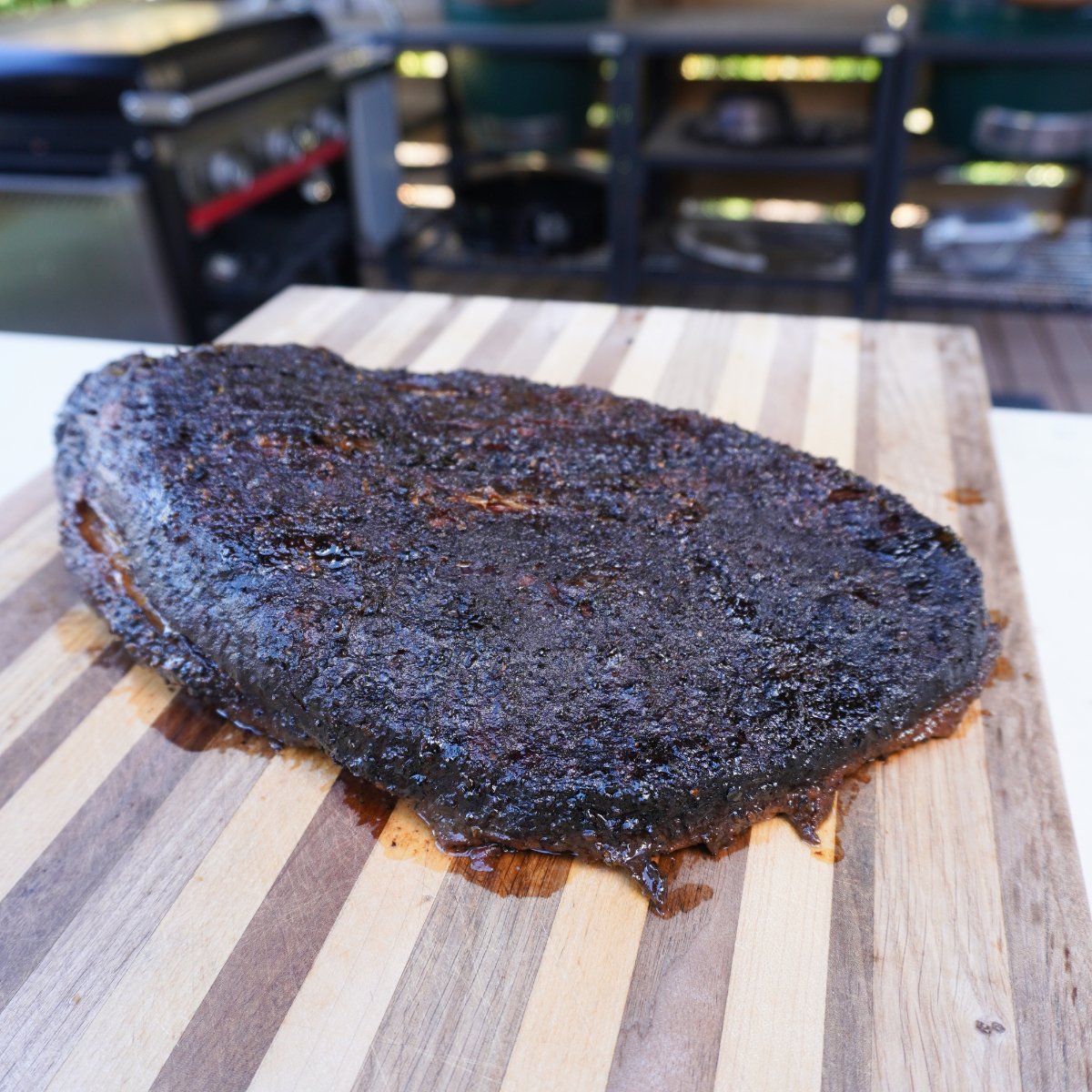
Resting the brisket is the final and just as an important process in smoking a brisket.
Remove the brisket off the grill and open the wrap to allow the steam to escape. This will stop the cooking process.
Next, wrap it back and place the smoked brisket in an insulated container such as a cooler or turned off oven. Let it rest for 1 hour.
Once rested, it’s finally time to enjoy your labor of love. Slice the brisket and enjoy!
Frequently Asked Questions:
Can I make this in the oven or stove top? All my recipes can be replicated in the oven, stove top or gas grill. You do not need a big green egg or weber grill to replicate any of my recipes.
Print
Smoked Brisket
A perfectly smoked brisket is the king of BBQ. Enjoy some tender, flavorful, and juicy smoked brisket using my method.
Course Main Course
Cuisine American
Keyword smoked brisket, beef brisket, smoking beef, smoked beef, how to smoke a brisket, pellet grill recipes, bbq food, grilling recipes, grill recipes, grillin with dad recipes, grilling with dad recipes.
Prep Time 30 minutes minutes
Cook Time 9 hours hours
Servings 8 People
Calories 1147kcal
- 13 lbs Beef brisket
- 4 tbsp Yellow mustard
- 1/4 cup Dad's all purpose seasoning
- 4 tbsp Coarse black pepper
Start by placing the brisket in the freezer for 1 hour. This will harden the fat making it easier to trim.
Using a trimming knife, slowly start sculpting the brisket, slice off loose fatty ends. Shape the brisket by removing thin and even slices of fat making the entire piece more aerodynamic. By the time you are done, there should be an even 1/4 inch of fat cap left on the top.
Spread yellow mustard all over the trimmed brisket which will work as a binder for the seasoning.
Season the trimmed brisket with a combination of my Dad's All Purpose seasoning and a layer of coarse ground black pepper. This will give the brisket a nice dark bark.
Preheat the smoker to a low 225 degrees. Make sure the hopper is full of pallets. Place the well seasoned brisket on the grates fat cap down and let it cook and smoke for the next 7-9 hours until it reaches 170 degrees internally and the bark is set.
Wrap the brisket tight with either butcher paper or aluminum foil. Make sure the is not air or space between the wrapping material and meat.
Increase the grill temperature to 275 degrees and place the wrapped brisket back on the grates.
Once the internal temperature reaches 200 degrees, check if the meat is probe tender. If not, continue to cook the brisket and check for probe tenderness every 30 minutes. The final internal temperature can range from 200-206 degrees.
Remove the brisket off the grill and open the wrap to allow the steam to escape.
Wrap it back and place the smoked brisket in an insulated container such as a cooler or turned off oven. Let it rest for 1 hour.
Calories: 1147kcal | Carbohydrates: 0.4g | Protein: 153g | Fat: 55g | Saturated Fat: 19g | Polyunsaturated Fat: 2g | Monounsaturated Fat: 26g | Trans Fat: 0.001g | Cholesterol: 457mg | Sodium: 665mg | Potassium: 2444mg | Fiber: 0.3g | Sugar: 0.1g | Vitamin A: 5IU | Vitamin C: 0.03mg | Calcium: 42mg | Iron: 14mg
The post Smoked Brisket appeared first on Grillin With Dad.
 Backyard GrillingWeekend WarriorsAdvice from DadBeard GroomingTV Shows for Guys4x4 Off-Road CarsMens FashionSports NewsAncient Archeology World NewsPrivacy PolicyTerms And Conditions
Backyard GrillingWeekend WarriorsAdvice from DadBeard GroomingTV Shows for Guys4x4 Off-Road CarsMens FashionSports NewsAncient Archeology World NewsPrivacy PolicyTerms And Conditions
